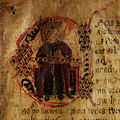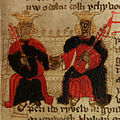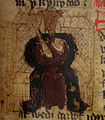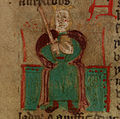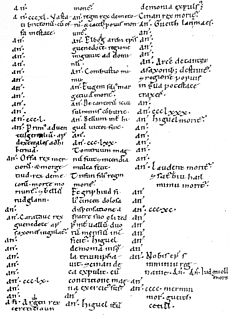
Annales Cambriae is the name given to a complex of Cambro-Latin chronicles compiled or derived from diverse sources at St David's in Dyfed, Wales. The earliest is a 12th-century presumed copy of a mid-10th century original; later editions were compiled in the 13th century. Despite the name, the Annales Cambriae record not only events in Wales, but also events in Ireland, Cornwall, England, Scotland and sometimes further afield, though the focus of the events recorded especially in the later two-thirds of the text is Wales.

The National Library of Wales, Aberystwyth, is the national legal deposit library of Wales and is one of the Welsh Government sponsored bodies. It is the biggest library in Wales, holding over 6.5 million books and periodicals, and the largest collections of archives, portraits, maps and photographic images in Wales. The Library is also home to the national collection of Welsh manuscripts, the National Screen and Sound Archive of Wales, and the most comprehensive collection of paintings and topographical prints in Wales. As the primary research library and archive in Wales and one of the largest research libraries in the United Kingdom, the National Library is a member of Research Libraries UK (RLUK) and the Consortium of European Research Libraries (CERL).
Peredur is the name of a number of men from the boundaries of history and legend in sub-Roman Britain. The Peredur who is most familiar to a modern audience is the character who made his entrance as a knight in the Arthurian world of Middle Welsh prose literature.
The Hengwrt Chaucer manuscript is an early-15th-century manuscript of the Canterbury Tales, held in the National Library of Wales, in Aberystwyth. It is an important source for Chaucer's text, and was possibly written by someone with access to original authorial holograph, now lost.

The Welsh Triads are a group of related texts in medieval manuscripts which preserve fragments of Welsh folklore, mythology and traditional history in groups of three. The triad is a rhetorical form whereby objects are grouped together in threes, with a heading indicating the point of likeness; for example, "Three things not easily restrained, the flow of a torrent, the flight of an arrow, and the tongue of a fool."

The White Book of Rhydderch is one of the most notable and celebrated surviving manuscripts in Welsh. Mostly written in southwest Wales in the middle of the 14th century it is the earliest collection of Welsh prose texts, though it also contains some examples of early Welsh poetry. It is now part of the collection of the National Library of Wales, having been preserved in the library at Hengwrt, near Dolgellau, Gwynedd, of the 17th century antiquary Robert Vaughan, who inherited it from the calligrapher John Jones and passed it to his descendants. The collection later passed to the newly established National Library of Wales as the Peniarth or Hengwrt-Peniarth Manuscripts.

The Black Book of Carmarthen is thought to be the earliest surviving manuscript written solely in Welsh. The book dates from the mid-13th century; its name comes from its association with the Priory of St. John the Evangelist and Teulyddog at Carmarthen, and is referred to as black due to the colour of its binding. It is currently part of the collection of the National Library of Wales, where it is catalogued as NLW Peniarth MS 1.

Brut y Tywysogion, also known as Brut y Tywysogyon, is one of the most important primary sources for Welsh history. It is an annalistic chronicle that serves as a continuation of Geoffrey of Monmouth’s Historia Regum Britanniae. Brut y Tywysogion has survived as several Welsh translations of an original Latin version, which has not itself survived. The most important versions are the one in Robert Vaughan's Peniarth MS. 20 and the slightly less complete one in the Red Book of Hergest. The version entitled Brenhinoedd y Saeson combines material from the Welsh annals with material from an English source.
'The five royal tribes of Wales' and 'The fifteen tribes of Gwynedd' refer to a class of genealogical lists which were compiled by Welsh bards in the mid-15th century. These non-identical lists were constructed on the premise that many of the leading Welsh families of their time could trace their descent to the 'five royal tribes of Wales' or the 'fifteen noble tribes of Gwynedd'.
Ieuan ab Owain Glyndŵr was reputedly the illegitimate son of the last native Welsh Prince of Wales; Owain Glyndŵr. The possibility of his existence was uncovered through the work of Peter Bartrum which is currently being edited by the University of Wales Aberystwyth. Ieuan ab Owain and his descendants are detailed in Peniarth Manuscript 287 in the hand of Robert Vaughan of Hengwrt (c.1592-1667) and also in the manuscript known as Harley 1969 by Griffith Hughes (1634–1665) - the original manuscripts are kept at the National Library of Wales, Aberystwyth and the British Library respectively.
Brenhinoedd y Saeson is the medieval title of three Middle Welsh annalistic chronicles known from three 14th-century manuscripts recording events from 682 to the English conquest of Wales in 1282. The title Brenhinoedd y Saeson is found only in the rubric to the earlier of the two surviving manuscripts of version S: the other two texts are commonly known as Brut y Tywysogion, but this title is found only in manuscripts of the late 16th century and cannot be considered authentic.
The genealogies from Jesus College MS 20 are a medieval Welsh collection of genealogies preserved in a single manuscript, Oxford, Bodleian Library, Jesus College, MS 20, folios 33r–41r. It presents the lineages of a number of medieval Welsh rulers, particularly those of south Wales. The manuscript was compiled in the late 14th century, but many genealogies are thought to be considerably older. The latest pedigrees to have been included in the tract are those of Llywelyn ab Iorwerth and Rhys Gryg. It shares some material with the earlier Harleian genealogies.
The White Book of Hergest was an important Welsh manuscript compiled in c. 1450. It contained many Welsh poems and prose texts and was a significant source for several antiquaries of the 17th and 18th centuries, but disappeared in the early 19th century, probably being destroyed in a fire in a London bookbinder's shop in around 1810.
The Chronicle of the Saxons is a Welsh-language chronicle running from 683 to 1197. One manuscript attributes it to Caradog of Llancarfan. It appears to consist primarily of passages of the Chronicle of the Princes and the Annals of Winchester, with other minor sources as well.
The Black Book of Chirk is a 13th-century Welsh language manuscript, known also as the Chirk Codex. It is Peniarth 29 of the National Library of Wales, and deals with legal and historical matters. It contains also an elegy addressed at Llywelyn ap Iorwerth; king of Wales. This poem is probably written by his grand son Llywelyn ap Gruffudd who lived in the 13th century.
The Peniarth Manuscripts, also known as the Hengwrt–Peniarth Manuscripts, are a collection of medieval Welsh manuscripts now held by the National Library of Wales in Aberystwyth. The collection was originally assembled by Robert Vaughan (c.1592–1667) of Hengwrt, Merionethshire, and in the 19th century was housed in Peniarth Mansion, Llanegryn, Merioneth. It contains some of the oldest and most important Welsh manuscripts in existence.
The General Manuscript Collection of the National Library of Wales includes three series of manuscripts: NLW Manuscript series; NLW ex series of Manuscripts; and, NLW Rolls. All manuscripts acquired by the Library through either donation or purchase are added to this open-ended series, either singly or in groups, if they are: a) in a format compatible with the collection, i.e. manuscript books or rolls, or unbound material that can be filed; and, b) not integral to an archive or individual collection. There is, however, much archival material, mostly correspondence, held in the General Manuscripts Collection. The holdings in the General Manuscript Collection are catalogued in the Handlist of manuscripts in the National Library of Wales, which focuses on those manuscripts in the National Library which are not part of the foundation collections; there were over fifteen thousand when the first volume of the handlist appeared in 1940, and the collection had increased to 23,233 by 31 March 1994.

Peniarth 481D is a late 15th-century illuminated manuscript in its original binding that is held at the National Library of Wales. It is also known as The Battles of Alexander the Great, a reference to the twenty-six miniatures that accompany the Latin text Historia de preliis Alexandri Magni. The volume also contains Disticha Catonis, and Historia trium Regum. The manuscript, which is one of the most lavishly decorated in the National Library, has examples of the work of an English scribe, a Flemish illuminator and a workshop in Cologne.
Amlawdd Wledig was a legendary king of sub-Roman Britain. The Welsh title [G]wledig, archaically Gwledic or Guletic and latinised Guleticus, is defined as follows: "lord, king, prince, ruler; term applied to a number of early British rulers and princes who were prominent in the defence of Britain about the time of the Roman withdrawal; (possibly) commander of the native militia ".


